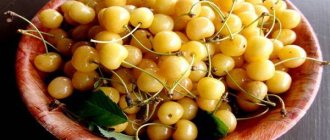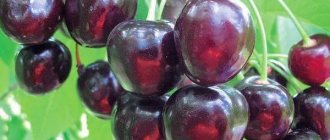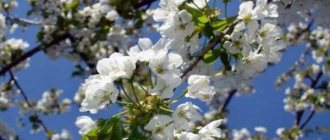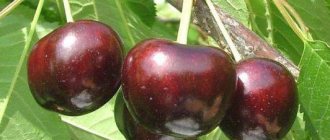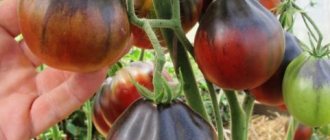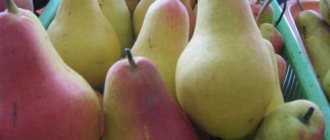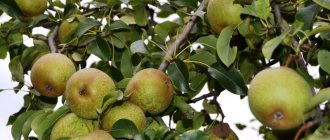History of selection of the Cordia variety
The Czech breeders, thanks to whom the variety appeared, gave it the name Kordit. Kordit largely owes its appearance not even to specialists in the field of breeding, but to the free pollination of a random seedling. The result of such a happy accident was the appearance of the most popular variety in Europe. It is also known in North America, but under the name Attica.
Important! The most abundant Cordia harvest can be expected from a tree grafted onto a medium- or low-growing rootstock.
Description of fruit and tree
The tree is grown in most regions where this species of Rosaceae grows, which, as is known, is thermophilic. Thus, the southern regions are preferable for it, although in the middle zone the variety is very popular in the north-west and central regions.
The seedling is characterized by intensive growth: a one-year-old tree reaches a height of 160–170 cm. When the tree grows and begins to bear fruit, the growth of wood mass decreases. Strong, voluminous roots are located close to the surface of the earth. The crown is not compact and may have a spherical or pyramidal shape.
Large leaves of a typical oval shape are distinguished by sufficient density, under which a certain amount of fruit is hidden during fruiting. The strong stalks reach a length of 4.5–5 cm. The berry itself is large: up to 2.6–2.8 cm in diameter and 9–12 g in weight, shaped like a heart. The skin is a beautiful dark burgundy color with a dense structure. The pulp is very juicy, ruby color, dense and fleshy. The large stone is easily separated from the pulp. The taste of the fruit is high (rated by experts as 4.8 points on a five-point scale).
The taste is characteristic of the culture, sweet, very pleasant, with a typical smell. The tree begins to bear fruit in the 4th–5th season. Fruits are formed on bouquet branches and on annual shoots. The yield of the variety is average: abundance is affected by weather conditions, care, and the presence of good pollination. Depending on these factors, the yield can be in the range of 24–48 kg per tree. Like most late varieties, the tree is self-sterile; it requires pollinators.
Did you know? Late cherries can act as a pollinator for early cherries. But for the tree itself, proximity to a cherry tree does not give anything.
In order to get a bountiful harvest, varieties with a close flowering period should grow nearby:
- Summit;
- Karina;
- Regina;
- Schneider late and etc.
Depending on the region and weather conditions, the variety can bloom in the third decade of April - the first half of May. In the southern regions, you can enjoy ripe cherries as early as the end of June. A pleasant feature of the variety is the fact that the ripe berry stays on the branch well and for quite a long time without falling off, i.e. the harvest can be harvested in several stages. Cordia loves moisture and does not respond well to drought.
Watering the tree is necessary, quite abundant and regular. This circumstance especially applies to young trees during the period of budding and ovary formation. Winter hardiness is not a strong feature of the variety. Young trees can be severely damaged by winter frosts; adults can tolerate short-term frosts down to -25°C, especially with a well-insulated trunk and a mulched tree trunk. Severe frosts usually lead to freezing of the tree.
Familiarize yourself with the rules for planting cherry seedlings in the spring.
In addition, return spring frosts during the flowering period can harm the future harvest. The crop has a fairly high resistance to most of its characteristic diseases, but monilial burn is dangerous for the tree. To avoid the risk of infection, fungicide treatment should be used, preventive measures should be followed, and fertilizing should be done to increase immunity.
Preparing Cordia cherries for winter
Basic procedures for preparing for the cold season should protect the tree from frost, as well as from the appearance of pests and diseases and include:
- cleaning fallen leaves;
- loosening the soil;
- pruning branches and whitening the lower part of the trunk (trunk);
- irrigation;
- feeding;
- trees under a canopy.
In addition to general preparatory measures, planting cherries, depending on the region, has its own characteristics. For example, in the Moscow region it is recommended to plant cherries on cherry trees to increase their resistance to low temperatures. In Siberia or the Urals, there is a practice of tilting trees to the north, which allows them to be tilted towards the ground and covered in winter. The entire range of work is quite wide, but its implementation is justified by high productivity.
Advantages and disadvantages of the variety
- The following advantages of Cordia are the most attractive for growing the variety:
- excellent taste and commercial quality;
- keeping quality and transportability;
- even the ripest cherries are resistant to cracking, almost do not rot (within a reasonable time frame), and tolerate high humidity;
- quite good stable yield;
- the tree grows quickly;
- versatility of berries;
- late periods of ripening, and therefore flowering, practically eliminate the possibility of falling under return frosts;
- due to the fact that a large number of fruits grow directly on shoots and branches, they are easy to collect;
- good immunity to most diseases, excellent resistance to cancer.
- Among the disadvantages of the variety, the following should be mentioned:
- poor winter hardiness;
- For a good, stable harvest, the presence of suitable pollinators is necessary.
Did you know? Food coloring is prepared from cherry fruits, which, oddly enough, is green.
Description of the variety
There is no information about the Czech variety Cordia, a popular cherry in Europe, in official Russian sources. It is not registered in the State Register and, accordingly, is not zoned in the regions of Russia. According to reviews from gardeners, this heat-loving cherry is grown in the southern regions of the country. But it was especially loved by gardeners and farmers in Ukraine, although even there it was not included in the Plant Register.
The tree grows quickly on vigorous rootstocks - in the first year the growth can be 1.5 meters. As fruiting begins, growth slows down and the crown takes on a spherical shape. Generative buds are formed mainly on bouquet branches and growths of the current year. Shoot-forming ability is high. Frost resistance of young plants is low and increases with age. Flower buds can be damaged by return frosts, but due to the late flowering period (it occurs in April - May), such cases are not too frequent. Drought resistance is also not one of Cordia's strengths. Fruit ripening dates are mid-late. The berries usually ripen in late June - early July. They are collected gradually, over 10-15 days. The berries adhere firmly to the stalks without falling off. The yield of the variety is high and annual.
The Cordia cherry is self-sterile and therefore needs pollinators. The sources recommend the following cherry varieties for these purposes:
- Regina;
- Karina;
- Summit;
- Wang;
- Burlat;
- Mercant.
The variety's berries are large (average weight 8-10 grams) and very attractive. They are heart-shaped and carmine-black with a hint of bronze. The clay is thin and resistant to cracking during rains. The pulp is dense, juicy, with a rich sweet taste.
The berries of the Cordia variety are large (with an average weight of 8-10 grams), very attractive
The fruits are universal in use, have good transportability and shelf life, which has earned them recognition from exporters.
Advantages and disadvantages of the Cordia cherry variety
To summarize, here is a list of the main advantages of the variety:
- Precociousness.
- Late flowering and ripening.
- High and regular yield.
- Extended period of fruit ripening.
- Attractive appearance of berries.
- Great taste.
- Fruit resistance to cracking.
- Universal purpose of berries.
- Transportability.
And, of course, about the disadvantages:
- Low winter hardiness and frost resistance.
- Insufficient drought resistance.
- Self-sterility.
Selecting the best seedlings for planting
The type of crown that forms on an adult tree depends on which rootstock the tree is grafted onto. Experienced gardeners, as well as professional breeders, pay attention to plants grafted on VLS-2 (a hybrid of plum and cherry).
On such trees, the crown begins to develop at a height of 0.7–0.8 m, subsequently forming a large amount of fruit wood. Seedlings grafted onto Bird cherry and F12/1 grow quickly and, accordingly, bring a quick harvest. It is better to go to a nursery to buy seedlings, so you will have guarantees that you have purchased high-quality material.
When choosing seedlings, try to pay attention to the following qualities:
- buy an annual seedling - it takes root most easily in a new place;
- the seedling should not have damage, signs of dryness or breakage;
- carefully examine the roots - they should be fairly developed, moist, almost white, without broken ends;
- the kidneys should not have the slightest sign of dryness, be alive and slightly swollen;
- Don't forget that Cordia needs a pollinator (you can purchase one from the same nursery).
After you purchase a tree, its root system (if it is bare, not in a container) is wrapped in a moistened rag and transported in this way, moistening the rag as necessary.
The tree should be planted as soon as possible after purchase. Learn how to graft sweet cherries onto cherry trees in the spring and summer.
Reviews from summer residents about Cordia cherries
Kirill Anatolyevich, 38, St. Petersburg Cordia is a very profitable cherry variety. My garden is small, just a few acres. I sowed only a tenth of the area with this variety. In terms of the beauty of the berries and their popularity on the market, late-ripening cherries can easily be compared with the first fruits. I bought it along with two other varieties that I use as pollinators. Alexandra Andreevna, 41 years old, Voronezh A seedling of the Cordia variety was purchased at an exhibition 3 years ago. Planted next to other types of cherries. We did not find any recommended pollinator varieties, but there are others besides cherries. I hope that from an adult tree, after pollination by neighboring cherries, you can collect at least 10 kilograms. At the same time, the tree enjoyed flowering for 4 years of growth. There aren't enough berries yet, but they are very tasty. Vladimir Nikolaevich, 54 years old, Volgograd Joy gives not only the excellent taste of the berries, but also a delightful aroma during flowering. I can say with confidence that Cordia is not demanding when it comes to pollination: despite the absence of varieties recommended for pollination in the areas, the trees bloom and bear fruit in large quantities.
Source – https://agrognom.ru/berries/sweet-cherry/chereshnya-kordiya.html
Features of planting cherries
Below we describe in detail the main points associated with planting a tree.
Landing dates
In the central regions, bare-rooted cherries are planted in the spring, before the buds swell. If you plant seedlings in containers, some foliage is acceptable. In the southern regions, cherries are also planted in the fall.
Selecting a location
When choosing a place to plant cherries in your garden, you should proceed from the following factors:
- Cherry is a heat-loving crop, that is, it needs a place open to the sun, but closed from drafts (fence, buildings, tall bushes);
- occurrence of groundwater - no closer than 2 m from the surface of the earth;
- the distance to the nearest tree or tall bush is at least 4–5 m.
In addition, it is advisable to find an area with light, loose and fertile soil with a neutral or slightly acidic pH (6.0–7.0). If your site does not have such soil, there is no need to be sad; further on we will tell you how the soil can be brought to the required conditions.
Check out these late cherry varieties:
How to plant Cordia cherries
Cordia loves fertile, loose and fairly moist, but not waterlogged soils. If the soil is clayey, it needs to be loosened and fed.
Important! If melt water accumulates in the area intended for planting, you must select a slide.
How to choose a seedling
For planting, it is recommended to use medium or vigorous rootstocks. This means that at the time of fruiting, after a few years, the growth of trees will slow down. Seedlings take root more easily at 1-2 years of age.
Planting dates and scheme
Planting times vary by region. In the south of the country, this species can be planted in the fall, before the onset of frost. In northern regions, it is best to plant in the spring to avoid the negative effects of the first autumn frosts.
Important! To avoid diseases, the tree is planted before the buds swell and the first shoots appear.
Pit preparation
The planting hole should be deep enough - about 1 meter - and the same width. It must be dug up in advance: when planting in the spring, it must be prepared in the fall, setting aside a fertile layer for the soil mixture.
A support is placed in the center of the hole, which will later serve as a windbreak and stopper for the seedling. Then the hole is filled with a special nutrient mixture consisting of:
- soil and humus - about 15 kilograms;
- ash – half a kilogram is enough;
- fertilizers - superphosphate in the amount of 100-200 grams.
The seedling is placed in a hole prepared in this way and carefully covered with earth, leaving the root collar free of soil (several centimeters above the roots). If the plant is covered deeply, it may die. It is also not recommended to dig the neck to avoid the appearance of a hole around the roots, in which water can accumulate. After planting Cordia cherries, the soil must be watered, loosened and peat, humus or sawdust added.
Aftercare of the tree
Caring for Cordia cherries has some features characteristic of this particular variety, but they are associated, first of all, with the relatively late ripening period. In the main points, caring for Cordia is similar to similar measures that need to be performed in relation to this type of tree in general.
Watering the plant
Although cherries do not like stagnant water near the roots, they need regular watering. The first watering, as already mentioned, is carried out immediately after planting. In the future, the frequency and volume of watering depend on how dry the summer was. During this period, weekly watering is required in the amount of 2-3 buckets of water per 1 m² of tree trunk circle.
As the tree grows, the diameter of the circle increases, and therefore the required volume of water. In addition to watering, which is done immediately after planting cherries, if there is a normal amount of precipitation in spring and summer, additional watering may be required only at the following stages of tree growth:
- 2 weeks after flowering.
- During the period of ovary formation.
- After the harvest is harvested.
- Before winter, after leaf fall, but no later than 3 weeks before the onset of frost.
Important! To avoid cracking of berries, within 15
–
20 days before harvesting, they stop watering the tree.
Soil feeding
There is no need to fertilize the tree the first autumn after planting (if you applied fertilizer when digging up the soil and planting, as described above). The first spring foliar feeding should be done during flowering. To do this, use a solution of urea or nitrogen nitrate (2 tbsp. l/1 l of water). The resulting solution is sprayed onto the leaves.
During this period, a solution of bird droppings is also used for foliar feeding. To spray one cherry, 100 g of poultry excrement should be dissolved and left for 3 days in 1/2 a bucket of water. After flowering, the green mass is treated with a solution of nitroammophoska (30 g/5 l of water).
During autumn work (second autumn, if the tree was planted in the spring), the following set of fertilizers is added to the tree trunk circle:
- humus - 1/2 bucket;
- ash - 1 tbsp.;
- superphosphate - 3 tbsp. l.;
- Potassium sulfate - 2 tbsp. l.
Fertilizers are first thoroughly mixed with humus, and then evenly embedded in the tree trunk circle.
Important! In the second half of spring, nitrogen fertilizing is applied (1
–
1.5 tbsp.
l./1 m² )
. They should not be used later, since the mineral weakens the frost resistance of the tree due to the intensive growth of young shoots that do not have time to grow stronger before frost.
Preparing for winter and whitewashing wood
Young cherries are especially vulnerable to frost, although mature trees should also be taken care of for winter insulation. In the fall, when the entire garden is being prepared for winter, dried bark and dry branches need to be removed from the cherries. Fallen leaves and berries should be removed from the adjacent land and burned outside the garden. Then they dig up the circle, apply fertilizer and carry out pre-winter watering. And only before the onset of the first frosts do they begin directly to insulate the trunk.
First of all, it must be whitened to the level of the beginning of the skeletal branches. Whitewashing the trunk has two functions: protection from pests and from bright sunlight reflected from the snow. If you live in the southern regions, the trunk is insulated only during the first 2–4 years of the tree’s life, then whitewashing will suffice. Whitewash is prepared from a proportional mixture of clay with slaked lime, to which copper sulfate is added. The resulting mash is used to whiten the standard.
In the first 2–4 years of a tree’s life, and further in more northern latitudes, the trunk can be additionally insulated and protected from rodents:
- Drive into the tree trunk circle, at a distance of 20–25 cm from the trunk, 5–6 stakes, the height of which would reach the skeletal branches of the tree.
- Wrap the outside of the stakes with a layer of roofing material and secure it with wire. Pour straw inside the resulting “reservoir”.
- Mulch the tree trunk circle with peat, straw or sawdust (you can mix these components). Place spruce branches on the mulch.
Since cherry is a tree that grows primarily in southern latitudes, in most of its growing area, insulating the trunk for the winter “in the maximum configuration” is most likely not required. Thus, the described method is necessary only in the first years of the tree’s life or in regions where more or less severe frosts may occur. For the rest, you can get by with just whitewashing.
Pruning branches
Pruning is the most important agricultural technique. The procedure has sanitary, rejuvenating and stimulating functions. In the spring (if the tree was planted in the same spring, the procedure is performed soon after planting), formative pruning is done:
- Up to four skeletal branches are left, which are cut to 2/3 of the length.
- The central conductor is cut so that the difference in height between it and the longest cut skeletal branch is approximately 20 cm.
- The remaining shoots are removed to the base, and the cut areas are treated with garden varnish.
In the second season, all young branches are cut to half. Pruning is also necessary for the reason that the tree does not branch very much, and the buds on which the fruits form grow more often on the side shoots. Although pruning a large portion of the growth reduces the yield in the very short term (smaller branches mean less fruit), in the long term it leads to increased yield and rejuvenation of the tree.
Cherries grow quite quickly. Every summer (late June-early July), young shoots must be cut back by 35–50 cm.
In addition, completely remove all shoots that:
- dried out, broke, froze;
- grow inside the crown;
- compete in growth with the central conductor, i.e. those branches that deviate from the conductor by less than 45°.
In other words, you should leave branches whose growth tends to be horizontal and directed outward. When the tree has grown enough, rejuvenating pruning is done. The procedure is performed in the spring, before the buds open, in dry sunny weather, otherwise the cherry may get sick.
Important! Regular pruning, in addition to its rejuvenating effect and positive effect on productivity, prevents the development of diseases and the appearance of parasites.
To avoid this, the operation should be performed with an instrument treated with an antiseptic, and the cut areas should be immediately covered with garden varnish. When carrying out anti-aging pruning, the main rule is to remove all the growth that has appeared over the last 3-5 seasons.
Diseases and pests
Cordia cherry has fairly good immunity to most diseases, but is vulnerable to fungal diseases:
- fruit rot (moniliosis);
- coccomycosis;
- perforated spotting (clasterosporiasis).
Moniliosis . The most favorable conditions for the development of the disease are high air humidity during the flowering period. The fungus Monilia penetrates through the pistil of a flower into the branches of a tree and grows in them. Branches attacked by the fungus look like they are burnt. Ignoring the disease can lead to the death of the tree.
Coccomycosis . A sign of the disease is the appearance of rusty spots on the foliage, then the leaf turns yellow and dies. As a result of the disease, the tree becomes weak and often unable to withstand winter cold, which leads to freezing.
Hole spot. The fungus affects all parts of the plant. The leaf blade is covered with dark spots, which then dry and fall out of the plate, forming holes in it. As a result, the berry loses moisture and dries out.
Pests that pose the greatest danger to cherries:
- aphid;
- cherry fly;
- cherry weevil;
- cherry slimy sawfly.
If there is an invasion of a fly or sawfly, it is quite possible to lose half the harvest or even a slightly larger volume. Because of aphids, young shoots become unable to develop.
To treat diseases and destroy pests, plants are treated with insecticides and fungicides throughout the entire growing season, except for flowering and harvesting. Treatments must be stopped no later than 20 days before harvest.
In addition, to reduce the risk of diseases and pests, preventive measures should be followed:
- regularly remove weeds, rotten and spoiled fruits, dry branches and leaves;
- fight ants that carry aphids;
- do not forget about the autumn and spring digging of the soil around the trunk;
- after autumn gardening work, a bare tree should remain, with dry areas of bark and branches completely removed, with a clean, dug-up trunk circle.
In the fight against pests and diseases of cherries, the method of treatment with tank mixtures has proven itself well. The method consists of spraying the tree with a mixture of insecticides and fungicides, a kind of universal poison. Prepare the solution just before use.
Preparations such as “Aktara”, “Enzhio”, “Aktellik” are used as insecticides. Among the fungicides, “Horus” and “Switch” have proven themselves well. The drugs are used according to the instructions attached to them.
Harvesting and storage rules
The harvest should be harvested and stored correctly, otherwise the cherries will not last for any significant time. Sweet cherries, as you know, have a very short shelf life, although Cordia has a shelf life compared to other varieties.
When harvesting, try to follow some rules, and then your harvest will have a marketable appearance and retain its taste longer:
- Harvesting should be done in dry, sunny weather early in the morning.
- The berries must be picked together with the stalks. By leaving them, you avoid causing mechanical damage to the fetus. In addition, the stalks contain a small amount of moisture and nutrients that prevent rapid spoilage of the fruit.
- The collected cherries should be carefully scattered on a spread garden film or tarpaulin in one layer so that the fruits do not get crushed.
- Only the best cherries, slightly unripe and medium in size, are selected for storage. Large, bursting, overripe ones should be consumed first.
- The berries must be thoroughly dried before storing.
Did you know? Sweet cherry, or bird cherry, was known to mankind back in the 6th millennium BC. e., and, most likely, this happened before people learned about ordinary cherries.
The method of storing fruits depends on how long you want to preserve the berries:
- up to 5 days - main compartment of the refrigerator;
- after harvest and until spring (8–9 months) - freezer;
- up to 1 year - heat drying or preservation.
Cordia cherries, of course, should be called a very successful variety, possessing such qualities as good taste, good shelf life and transportability for this type, and excellent appearance. Due to the versatility of using the fruit, the variety is suitable for both industrial cultivation and your own garden.


